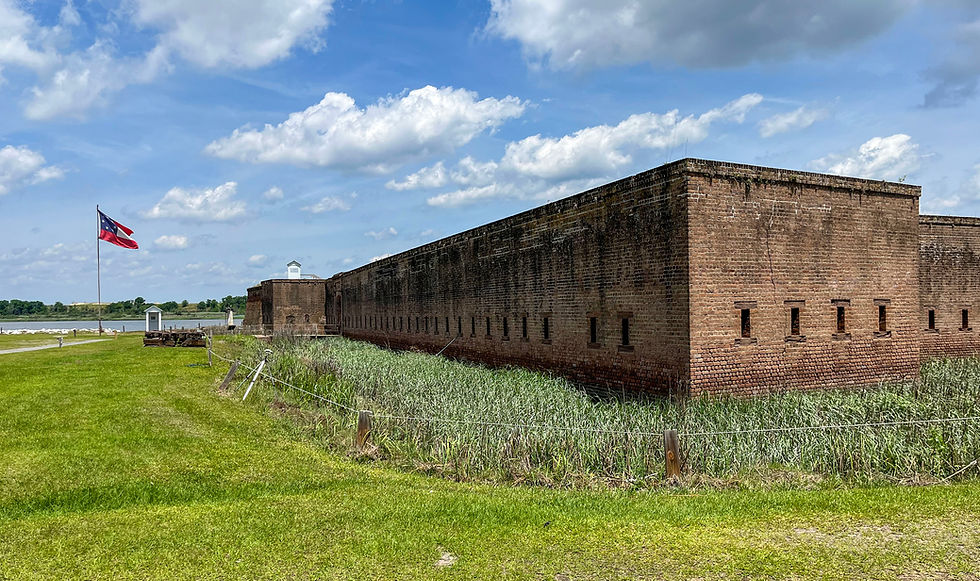Fort Monroe: Freedom's Fortress
- Tim Murphy

- Apr 14, 2017
- 7 min read
Updated: Apr 24, 2021
Hampton Roads is a vibrant area in Virginia submersed in a 400 year history and a staple in the military community. Fort Monroe has been a major contributor to Hampton's culture and livelihood for over 180 of those years. Constructed in 1834, Fort Monroe was (and still is) the largest moat-entrenched stone fortification in the United States. It played a key role in the Civil War, serving as the Union army's only fortress on the Virginia Peninsula and a sanctuary for runaway slaves, known as "contrabands." Hence its nickname "Freedom Fortress." Today, the fort has been deactivated from the army and stands quietly as a symbol of freedom and national strength.

Fort Monroe's history begins 200 years before its inception in 1608, when colonists of the London Company anchored their ships at a place they called "Point Comfort." Captain John Smith built Fort Algernourne to protect the Jamestown colony further up the river. Unfortunately, Algernourne burned to the ground in 1612 and the replacement fortifications quickly deteriorated. In 1728, Governor William Gooch and the House of Burgesses appropriated funds to build Fort George (named after King George II), described as the most powerful fort in the colonies. Despite its power and might, Fort George was swept away by a hurricane in 1749.
With no fortifications, the entrance to the James River on the peninsula was left vulnerable. During the War of 1812, the British attacked Hampton. They used the lighthouse (which still stands today) as a signal point and proceeded to pillage the coastal towns. After the British withdrawal from the peninsula, plans were made by the American government to fortify the area. In 1819, ground breaks for Fort Monroe's construction. The US Army sent four prestigious graduates from the Corps of Engineers to oversee Monroe's development: Lieutenant Colonel Charles Gratiot, Superintendent Rene Edward Derussy, Captain Andrew Talcott, and then-Assistant Engineer Robert E. Lee.
Military activities still took place while the fort was being built. Units of men and armaments were increasingly installed there throughout the 1820s and 30s. Edgar Allen Poe was actually stationed as a Sergeant Major with the 1st Regimental Artillery from December 1828 to April 1829 under the alias Edgar A. Perry. The first ten companies stationed at Monroe were merged into one big regiment named the "artillery corps of instruction," tasked to lead and teach troops in artillery practice. The first commanding officer of this regiment was Colonel John Rodgers Fenwick, but the majority of the instruction was led by Brevet Colonel Abraham Eustis (whom Ft. Eustis is named after).

At the outbreak of the Civil War, the US government was determined to keep Fort Monroe in Union hands and deployed 3600 troops to Hampton to prevent Confederate takeover. The investment paid off and Monroe was never taken during the war. Apart from being one of the very few Union fortifications in Confederate territory, Fort Monroe served another, more humanitarian purpose. On May 23, 1861, three slaves--Frank Baker, James Townsend, and Sheppard Mallory--escaped from Confederate labor camps and sought sanctuary at Fort Monroe. When their master tried to claim them, Major General Benjamin Butler, the fort's acting commander, declared runaway slaves to be contraband of war. Word quickly spread, and hundreds of other "contrabands" fled to Monroe for safety. Butler utilized the able-bodied men in supporting Union operations and established camps for the runaways just outside the fort, collectively known as "Slabtown." These camps provided food, shelter, and education for African Americans.
On June 6, 1861, Major General John Magruder (CSA) positioned his troops around Big Bethel Church, a few miles away from Fort Monroe. Wary of the Confederate advance and seeking a path to Richmond, Major General Butler ordered for troops to march to that position. On June 10, 1861, a battalion of 4400 Union troops under the command of Brigadier General Ebenezer Pierce arrived at Big Bethel, and what followed was the first land battle of the Civil War. The numbers clearly favored the North, but their forces were repulsed. Members of the 1st North Carolina, under commander D.H. Hill, halted the advance and forced the retreat of the 3rd New York and Zouave regiments after retaking their battery positions. The main attacks on the Confederate redoubts also yielded no progress. Major Theodore Winthrop, the commander of the final assault on Confederate positions, was shot trying to mobilize his troops by Sam Ashe of the 1st North Carolina, who ironically enough was African American. The loss of their leader severely damped the Federal's spirits and they soon withdrew back to Fort Monroe. The first battle of the Civil War ended in an embarrassing Northern defeat and a triumphant Confederate victory.
Concerned with the Confederate positions surrounding Fort Monroe, Butler ordered aerial observation via hot air balloon, the first time this had been used in combat. However, the Confederates were closer than expected. On August 6, 1861, General Magruder burned Hampton to the ground to keep it out of the hands of the North. The area was later converted into a contraband camp. In terms of troop deployment, there were no other major assaults on the peninsula during that year; however, Fort Monroe served as a launch site for amphibious assaults up and down the Atlantic coastline.

McClellan started his campaign April 4, 1862, but his advance was soon halted at Yorktown. Wanting greater action, President Abraham Lincoln decided to come down to Fort Monroe himself. He was joined by Secretary of War Edwin M. Stanton, Secretary of Treasury Salmon P. Chase, and Brigadier General Egbert Velie. Lincoln pressured an invasion force to take Confederate positions around Norfolk after he witnessed another US navy invasion repelled by the CSS Virginia. Union forces under General John Ellis Wool attacked Norfolk on May 9, 1862, and the following day controlled the town. The CSS Virginia, without grounded military support, was abandoned and set ablaze, thus ending the threat in the James.
For the rest of the war, Fort Monroe served as a key Union position for troop transportation and deployment. Additionally, in 1862, the Chesapeake Military Hospital was constructed in the fort to treat Union and Confederate wounded. A separate facility was built to treat colored troops. Harriet Tubman frequently brought folks for treatment her during their journey along the Underground Railroad.
In January 1865, Lincoln once again visited Fort Monroe, this time for the Hampton Roads Peace Conference with Confederate Vice President Alexander Stephens. This feeble attempt at peace made no progress, despite the increasingly bleak position the CSA was in. Later that April, Richmond fell and General Robert E. Lee later surrendered his Army of Northern Virginia at Appomattox. Jefferson Davis fled Richmond before it fell, but he was later captured in Georgia May 10, 1865, and brought to Fort Monroe as a prison two weeks later. Davis stayed here for two years until he was finally released on May 13, 1867.
On April 1, 1868, the Artillery School was reopened and in 1869 the first graduating class received their diplomas. General William Tecumseh Sherman personally handed each one out. The school operated for thirty years until it was temporarily shut down due to the outbreak of the Spanish-American War in 1898.
Throughout the 20th Century, Fort Monroe underwent significant changes modernizing weapons and defense. In 1907, Fort Monroe housed five mine-planting units and served as a submarine mine school. Additionally, with the utilization weaponized aircraft during both World Wars, Fort Monroe became a training ground for antiaircraft defense. Monroe remained an active military base until 2011 until it was deactivated. In November that same year, the fort was signed over to the National Parks Service.
The drive into Fort Monroe was very easy...right off of I-64. And the community around the fort was what you'd expect a picturesque military town to look like. I had to drive over the moat and through the main gate to get into the fort, which I thought was pretty cool. My first stop was the Casemate Museum which chronologically depicted Hampton's and Fort Monroe's histories and told the stories of key military personnel who resided there over the years. The Casemate itself is a large vaulted chamber within the walls of the fort, once used for gun placements and living quarters. It was very cool to see all of the artifacts on display. One exhibit showed an 1861 Parrott Gun that had been excavated from somebody's backyard (!), which goes to show that you never know what lies beneath your feet. I also walked through Jefferson Davis's old cell which was incredibly awesome!

After looking through the exhibits, I embarked on the self-guided walking tour around the fort. Just outside of the museum stands Quarters #17, originally Robert E. Lee's residence during the fort's construction. The next stop was the Flagstaff Bastion, which provides visitors with a great vantage point of the Chesapeake Bay.
The next destination was the Lincoln Gun, a 15-inch Rodman gun cast in 1860, the first of its kind. It fired projectiles over 300-lbs in weight at a range of nearly three miles. The gun is situated next to the Parade Grounds and the "Algernourne Oak," a 500 year-old tree still standing and growing to this day. Further down the road stands Quarters #1. This building was constructed in 1819 and is the oldest building inside the fort. General Butler occupied these quarters in 1861 and President Lincoln stayed here during his visit in 1862.
The walking tour continued outside of the fort to the old Water Batteries and powder magazines. Walking around the fort, I found the Old Point Comfort Lighthouse. Built in 1802, it is the oldest standing structure at Fort Monroe. This is the same tower that was taken over by British troops during the War of 1812. It still operates to this day. Across the street is where the first Africans arrived in 1619 aboard the White Lion. Further inland is the location of the original forts: Algernourne and George. The tour ends walking back through the Main Gate.
I had a wonderful time at Fort Monroe! The town was serene and quiet and there was so much to explore. You can easily spend over two hours here walking around the grounds and touring the museum. Additionally, there is a beach just to the north of the fort and a number of fishing spots along the coast one could visit. Not to mention this is all free, too! If you want to learn more about US military history, Fort Monroe is the place to go!






























